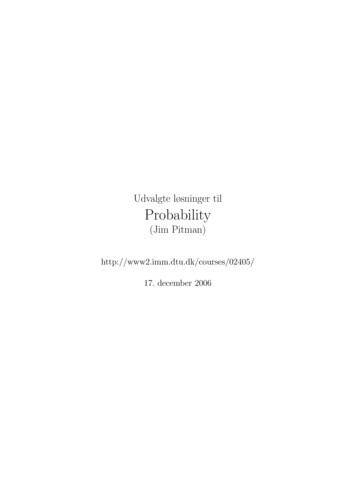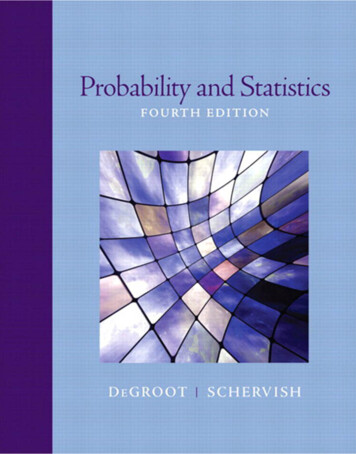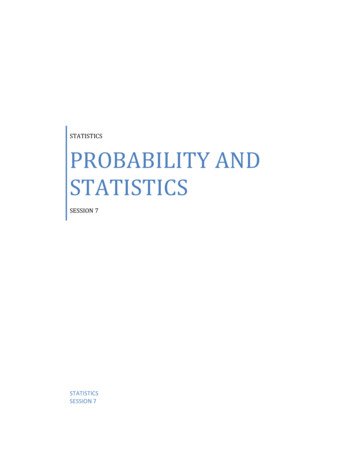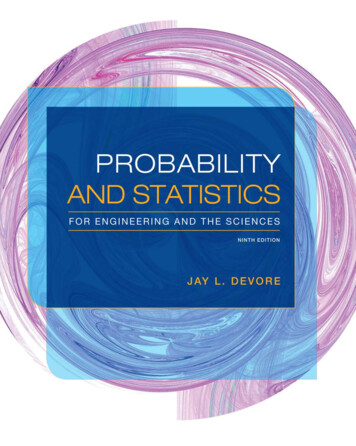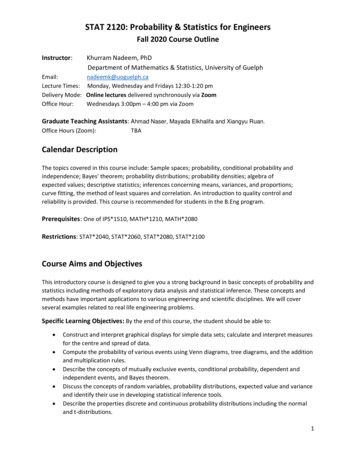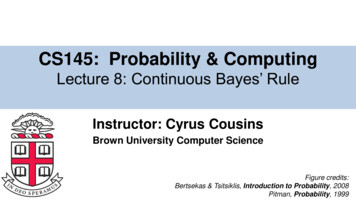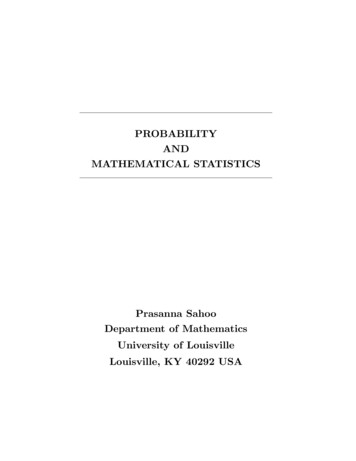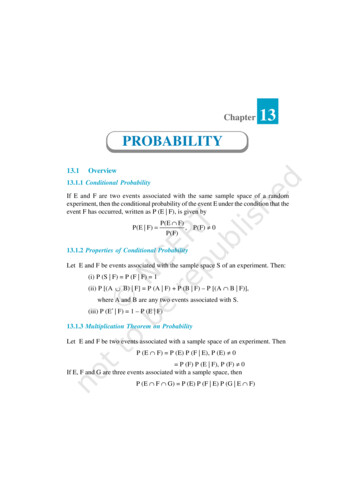
Transcription
Chapter13PROBABILITY13.1Overview13.1.1 Conditional ProbabilityIf E and F are two events associated with the same sample space of a randomexperiment, then the conditional probability of the event E under the condition that theevent F has occurred, written as P (E F), is given byP(E F) P(E F)P(F), P(F) 013.1.2 Properties of Conditional ProbabilityLet E and F be events associated with the sample space S of an experiment. Then:(i) P (S F) P (F F) 1(ii) P [(A B) F] P (A F) P (B F) – P [(A B F)],where A and B are any two events associated with S.(iii) P (E′ F) 1 – P (E F)13.1.3 Multiplication Theorem on ProbabilityLet E and F be two events associated with a sample space of an experiment. ThenP (E F) P (E) P (F E), P (E) 0 P (F) P (E F), P (F) 0If E, F and G are three events associated with a sample space, thenP (E F G) P (E) P (F E) P (G E F)
PROBABILITY25913.1.4 Independent EventsLet E and F be two events associated with a sample space S. If the probability ofoccurrence of one of them is not affected by the occurrence of the other, then we saythat the two events are independent. Thus, two events E and F will be independent, if(a)P (F E) P (F), provided P (E) 0(b)P (E F) P (E), provided P (F) 0Using the multiplication theorem on probability, we have(c)P (E F) P (E) P (F)Three events A, B and C are said to be mutually independent if all the followingconditions hold:P (A B) P (A) P (B)P (A C) P (A) P (C)P (B C) P (B) P (C)P (A B C) P (A) P (B) P (C)and13.1.5 Partition of a Sample SpaceA set of events E1, E2,., En is said to represent a partition of a sample space S if(a)Ei Ej φ, i j; i, j 1, 2, 3,., n(b)Ei E2 . En S, and(c)Each Ei φ, i. e, P (Ei) 0 for all i 1, 2, ., n13.1.6 Theorem of Total ProbabilityLet {E1, E, ., En} be a partition of the sample space S. Let A be any event associatedwith S, thennP (A) P(Ej 1j)P(A E j )
260MATHEMATICS13.1.7 Bayes’ TheoremIf E1, E2,., En are mutually exclusive and exhaustive events associated with a samplespace, and A is any event of non zero probability, thenP(E i A) P(E i )P(A Ei )n P(E )P(A E )ii 1i13.1.8 Random Variable and its Probability DistributionA random variable is a real valued function whose domain is the sample space of arandom experiment.The probability distribution of a random variable X is the system of numbersX:x1x2.xnP (X) :p1p2.pnnwhere pi 0, i 1, 2,., n, pi 1 1.i13.1.9 Mean and Variance of a Random VariableLet X be a random variable assuming values x 1, x 2,., x n with probabilitiesp1, p2, ., pn, respectively such that pi 0,n pii 1 1 . Mean of X, denoted by µ [orexpected value of X denoted by E (X)] is defined asnμ E (X) xi pii 1and variance, denoted by σ2, is defined as 2 n ( xi – ) 2 pi i 1n x2ii 1pi – 2
PROBABILITY261or equivalentlyσ2 E (X – )2Standard deviation of the random variable X is defined as variance (X) n (xi– )2 pii 113.1.10 Bernoulli TrialsTrials of a random experiment are called Bernoulli trials, if they satisfy the followingconditions:(i)There should be a finite number of trials(ii)The trials should be independent(iii)Each trial has exactly two outcomes: success or failure(iv)The probability of success (or failure) remains the same in each trial.13.1.11 Binomial DistributionA random variable X taking values 0, 1, 2, ., n is said to have a binomial distributionwith parameters n and p, if its probability distibution is given byP (X r) ncr pr qn–r,where q 1 – p and r 0, 1, 2, ., n.13.2 Solved ExamplesShort Answer (S. A.)A and B are two candidates seeking admission in a college. The probabilitythat A is selected is 0.7 and the probability that exactly one of them is selected is 0.6.Find the probability that B is selected.Example1Solution Let p be the probability that B gets selected.P (Exactly one of A, B is selected) 0.6 (given) P (A is selected, B is not selected; B is selected, A is not selected) 0.6 P (A B′) P (A′ B) 0.6
262MATHEMATICS P (A) P (B′) P (A′) P (B) 0.6 (0.7) (1 – p) (0.3) p 0.6 p 0.25Thus the probability that B gets selected is 0.25.Example 2 The probability of simultaneous occurrence of at least one of two eventsA and B is p. If the probability that exactly one of A, B occurs is q, then prove thatP (A′) P (B′) 2 – 2p q.Solution Since P (exactly one of A, B occurs) q (given), we getP (A B) – P ( A B) q p – P (A B) q P (A B) p – q 1 – P (A′ B′) p – q P (A′ B′) 1 – p q P (A′) P (B′) – P (A′ B′) 1 – p q P (A′) P (B′) (1 – p q) P (A′ B′) (1 – p q) (1 – P (A B)) (1 – p q) (1 – p) 2 – 2p q.Example 3 10% of the bulbs produced in a factory are of red colour and 2% are redand defective. If one bulb is picked up at random, determine the probability of its beingdefective if it is red.Solution Let A and B be the events that the bulb is red and defective, respectively.P (A) 101 ,100 10P (A B) 21 10050
PROBABILITYP (B A) 263P (A B)1 10 1 P (A)50 1 5Thus the probability of the picked up bulb of its being defective, if it is red, is1.5Example 4 Two dice are thrown together. Let A be the event ‘getting 6 on the firstdie’ and B be the event ‘getting 2 on the second die’. Are the events A and Bindependent?Solution:A {(6, 1), (6, 2), (6, 3), (6, 4), (6, 5), (6, 6)}B {(1, 2), (2, 2), (3, 2), (4, 2), (5, 2), (6, 2)}A B {(6, 2)}P(A) 6 11 , P(B) ,36 66P(A B) 136Events A and B will be independent ifP (A B) P (A) P (B)i.e., LHS P ( A B) 11 1 1, RHS P ( A ) P ( B) 366 6 36Hence, A and B are independent.Example 5 A committee of 4 students is selected at random from a group consisting 8boys and 4 girls. Given that there is at least one girl on the committee, calculate theprobability that there are exactly 2 girls on the committee.Solution Let A denote the event that at least one girl will be chosen, and B the eventthat exactly 2 girls will be chosen. We require P (B A).SinceA denotes the event that at least one girl will be chosen, A′ denotes that no girlis chosen, i.e., 4 boys are chosen. ThenP (A′) 8C4 70 14 C4 495 9912
264MATHEMATICS P (A) 1–14 85 99 998C 2 . 4C 2Now P (A B) P (2 boys and 2 girls) 12C4 Thus P (B A) 6 28 56 495 165P (A B) 56 99 168 P (A)165 85 425Example 6 Three machines E1, E2, E3 in a certain factory produce 50%, 25% and25%, respectively, of the total daily output of electric tubes. It is known that 4% of thetubes produced one each of machines E1 and E2 are defective, and that 5% of thoseproduced on E3 are defective. If one tube is picked up at random from a day’s production,calculate the probability that it is defective.Solution: Let D be the event that the picked up tube is defectiveLet A1 , A2 and A3 be the events that the tube is produced on machines E1 , E2 and E3,respectively .P (D) P (A1) P (D A1) P (A2) P (D A2) P (A3) P (D A3)P (A1) Also50111 , P (A2) , P (A3) 100 244P (D A1) P (D A2) P (D A3) 41 100 2551 .100 20Putting these values in (1), we getP (D) 111111 225 425 42011117 .04255010080 400(1)
PROBABILITY265Example 7 Find the probability that in 10 throws of a fair die a score which is amultiple of 3 will be obtained in at least 8 of the throws.Solution Here success is a score which is a multiple of 3 i.e., 3 or 6.Therefore,p (3 or 6) 2 1 6 3The probability of r successes in 10 throws is given byr 1 2 P (r) Cr 3 3 10– r10NowP (at least 8 successes) P (8) P (9) P (10)829110 1 2 1 2 1 C8 10 C9 10 C10 3 3 3 3 3 101201.10 [45 4 10 2 1] 3103 Example 8 A discrete random variable X has the following probability distribution:X1P (X) C234 52C 2C3C C2672C2 7C2 CFind the value of C. Also find the mean of the distribution.SolutionSince Σ pi 1, we haveC 2C 2C 3C C2 2C2 7C2 C 1i.e.,10C2 9C – 1 0i.e.(10C – 1) (C 1) 0 C 1,10Therefore, the permissible value of C C –11(Why?)10
266MATHEMATICSnMean xi pi i 17 xipii 122 1 2 1 1 1 1 2 3 4 5 6 2 7 7 10 10 10101010 10 10 12 21 4 36 12 5 12 49 710 10 10 10 100 100 100 10 3.66.Long Answer (L.A.)Example 9 Four balls are to be drawn without replacement from a box containing8 red and 4 white balls. If X denotes the number of red ball drawn, find the probabilitydistribution of X.Solution Since 4 balls have to be drawn, therefore, X can take the values 0, 1, 2, 3, 4.P (X 0) P (no red ball) P (4 white balls)4 12C41 C4495P (X 1) P (1 red ball and 3 white balls) 8C1 4 C3 32 12C4495P (X 2) P (2 red balls and 2 white balls) 8C 2 4 C 2 168 12C4495P (X 3) P (3 red balls and 1 white ball) 8C3 4 C1 224 12C4495
PROBABILITYP (X 4) P (4 red balls) 812267C470 .C4495Thus the following is the required probability distribution of XX01P (X)14953249523416849522449570495Example 10 Determine variance and standard deviation of the number of heads inthree tosses of a coin.Solution Let X denote the number of heads tossed. So, X can take the values 0, 1, 2,3. When a coin is tossed three times, we getSample space S {HHH, HHT, HTH, HTT, THH, THT, TTH, TTT}P (X 0) P (no head) P (TTT) 18P (X 1) P (one head) P (HTT, THT, TTH) 38P (X 2) P (two heads) P (HHT, HTH, THH) P (X 3) P (three heads) P (HHH) 18Thus the probability distribution of X is:X012 3P (X)18383 18 8Variance of X σ2 Σ x2i pi – µ2,where µ is the mean of X given by183838µ Σ xi pi 0 1 2 3 (1)1838
268MATHEMATICS 32(2)Now183838182222Σ x2i pi 0 1 2 3 3(3)From (1), (2) and (3), we get23 3 σ 3– 2 422Standard deviation 33 .42Example 11 Refer to Example 6. Calculate the probability that the defective tube wasproduced on machine E1.Solution Now, we have to find P (A1 / D).P (A1 / D) P (A1 D) P (A1 ) P (D / A1 ) P (D)P (D)1 1 2 25 8 1717 .400Example 12 A car manufacturing factory has two plants, X and Y. Plant X manufactures70% of cars and plant Y manufactures 30%. 80% of the cars at plant X and 90% of thecars at plant Y are rated of standard quality. A car is chosen at random and is found tobe of standard quality. What is the probability that it has come from plant X?Solution Let E be the event that the car is of standard quality. Let B1 and B2 be theevents that the car is manufactured in plants X and Y, respectively. NowP (B1) 70 730 3 , P (B2) 100 10100 10P (E B1) Probability that a standard quality car is manufactured in plant
PROBABILITY 26980 8 100 1090 9 100 10P (B1 E) Probability that a standard quality car has come from plant XP (E B2) P (B1 ) P (E B1 )P (B1 ) . P (E B1 ) P (B2 ) . P (E B2 )7 8 561010 7 8 3 983 10 10 10 10Hence the required probability is56.83Objective Type QuestionsChoose the correct answer from the given four options in each of the Examples 13 to 17.Example 13 Let A and B be two events. If P (A) 0.2, P (B) 0.4, P (A B) 0.6,then P (A B) is equal to(A) 0.8(B) 0.5(C) 0.3(D) 0Solution The correct answer is (D). From the given data P (A) P (B) P (A B).This shows that P (A B) 0. Thus P (A B) P (A B) 0.P (B)Example 14 Let A and B be two events such that P (A) 0.6, P (B) 0.2, andP (A B) 0.5.Then P (A′ B′) equals(A)110(B)310(C)38(D)67Solution The correct answer is (C). P (A B) P (A B) P (B) 0.5 0.2 0.1
270MATHEMATICSP (A′ B′) P (A′ B′ ) P[(A B′ )] 1– P ( A B ) P (B′)P (B′ )1– P (B) 1– P (A) – P (B) P (A B)3 .1– 0.28Example 15 If A and B are independent events such that 0 P (A) 1 and0 P (B) 1, then which of the following is not correct?(A) A and B are mutually exclusive(B) A and B′ are independent(C) A′ and B are independent(D) A′ and B′ are independentSolution The correct answer is (A).Example 16 Let X be a discrete random variable. The probability distribution of X isgiven below:X3010– 10P (X)1531012Then E (X) is equal to(A) 6(B) 4Solution The correct answer is (B).(C) 3(D) – 5131E (X) 30 10 –10 4 .5102Example 17 Let X be a discrete random variable assuming values x1, x2, ., xn withprobabilities p1, p2, ., pn, respectively. Then variance of X is given by(A) E (X2)(D)(B) E (X2) E (X)(C) E (X2) – [E (X)]2E (X 2 ) – [E (X)]2SolutionThe correct answer is (C).Fill in the blanks in Examples 18 and 19Example 18 If A and B are independent events such that P (A) p, P (B) 2p andP (Exactly one of A, B) 5, then p 9
PROBABILITYSolution p 1 5,3 12271 2 5 (1–p )( 2 p ) p (1 – 2 p ) 3 p – 4 p 9 Example 19 If A and B′ are independent events then P (A′ B) 1 –Solution P (A′ B) 1 – P (A B′) 1 – P (A) P (B′)(since A and B′ are independent).State whether each of the statement in Examples 20 to 22 is True or FalseExample 20 Let A and B be two independent events. Then P (A B) P (A) P (B)Solution False, because P (A B) P (A) . P(B) when events A and B are independent.Example 21 Three events A, B and C are said to be independent if P (A B C) P (A) P (B) P (C).Solution False. Reason is that A, B, C will be independent if they are pairwiseindependent and P (A B C) P (A) P (B) P (C).Example 22 One of the condition of Bernoulli trials is that the trials are independentof each other.Solution:True.13.3 EXERCISEShort Answer (S.A.)1.For a loaded die, the probabilities of outcomes are given as under:P(1) P(2) 0.2, P(3) P(5) P(6) 0.1 and P(4) 0.3.The die is thrown two times. Let A and B be the events, ‘same number eachtime’, and ‘a total score is 10 or more’, respectively. Determine whether or notA and B are independent.2.Refer to Exercise 1 above. If the die were fair, determine whether or not theevents A and B are independent.3.The probability that at least one of the two events A and B occurs is 0.6. If A andB occur simultaneously with probability 0.3, evaluate P( A ) P( B ).4.A bag contains 5 red marbles and 3 black marbles. Three marbles are drawn oneby one without replacement. What is the probability that at least one of the threemarbles drawn be black, if the first marble is red?
272MATHEMATICS5.Two dice are thrown together and the total score is noted. The events E, F andG are ‘a total of 4’, ‘a total of 9 or more’, and ‘a total divisible by 5’, respectively.Calculate P(E), P(F) and P(G) and decide which pairs of events, if any, areindependent.6.Explain why the experiment of tossing a coin three times is said to have binomialdistribution.7.A and B are two events such that P(A) Find :(i) P(A B)8.(ii) P(B A)111, P(B) and P(A B) .234(iii) P(A' B)Three events A, B and C have probabilities(iv) P(A' B')2 11, and , respectively. Given5 329.11and P(B C) , find the values of P(C B) and P(A' C').45Let E1 and E2 be two independent events such that p(E1) p1 and P(E2) p2.Describe in words of the events whose probabilities are:(i) p1 p2(ii) (1–p1) p2(iii) 1–(1–p1)(1–p2) (iv) p1 p2 – 2p1p210.A discrete random variable X has the probability distribution given as below:that P(A C) XP(X)11.(i)(ii)Prove(i)(ii)0.511.52kk22k 2kFind the value of kDetermine the mean of the distribution.thatP(A) P(A B) P(A B )P(A B) P(A B) P(A B ) P( A B)12. If X is the number of tails in three tosses of a coin, determine the standarddeviation of X.13. In a dice game, a player pays a stake of Re1 for each throw of a die. Shereceives Rs 5 if the die shows a 3, Rs 2 if the die shows a 1 or 6, and nothing
PROBABILITY273otherwise. What is the player’s expected profit per throw over a long series ofthrows?14. Three dice are thrown at the sametime. Find the probability of getting threetwo’s, if it is known that the sum of the numbers on the dice was six.15. Suppose 10,000 tickets are sold in a lottery each for Re 1. First prize is ofRs 3000 and the second prize is of Rs. 2000. There are three third prizes of Rs.500 each. If you buy one ticket, what is your expectation.16. A bag contains 4 white and 5 black balls. Another bag contains 9 white and 7black balls. A ball is transferred from the first bag to the second and then a ballis drawn at random from the second bag. Find the probability that the ball drawnis white.17. Bag I contains 3 black and 2 white balls, Bag II contains 2 black and 4 whiteballs. A bag and a ball is selected at random. Determine the probability of selectinga black ball.18. A box has 5 blue and 4 red balls. One ball is drawn at random and not replaced.Its colour is also not noted. Then another ball is drawn at random. What is theprobability of second ball being blue?19. Four cards are successively drawn without replacement from a deck of 52 playingcards. What is the probability that all the four cards are kings?20. A die is thrown 5 times. Find the probability that an odd number will come upexactly three times.21. Ten coins are tossed. What is the probability of getting at least 8 heads?22. The probability of a man hitting a target is 0.25. He shoots 7 times. What is theprobability of his hitting at least twice?23. A lot of 100 watches is known to have 10 defective watches. If 8 watches areselected (one by one with replacement) at random, what is the probability thatthere will be at least one defective watch?
274MATHEMATICS24. Consider the probability distribution of a random variable X:X01234P(X)0.10.250.30.20.15 X Calculate (i) V (ii) Variance of X. 2 25. The probability distribution of a random variable X is given below:X0123P(X)kk2k4k8(i)Determine the value of k.(ii)Determine P(X 2) and P(X 2)(iii)Find P(X 2) P (X 2).26. For the following probability distribution determine standard deviation of therandom variable X.X234P(X)0.20.50.327. A biased die is such that P(4) 1and other scores being equally likely. The die10is tossed twice. If X is the ‘number of fours seen’, find the variance of therandom variable X.28. A die is thrown three times. Let X be ‘the number of twos seen’. Find theexpectation of X.29. Two biased dice are thrown together. For the first die P(6) being equally likely while for the second die, P(1) 1, the other scores22and the other scores are5
PROBABILITY275equally likely. Find the probability distribution of ‘the number of ones seen’.30.Two probability distributions of the discrete random variable X and Y are ve that E(Y2) 2 E(X).31.A factory produces bulbs. The probability that any one bulb is defective is150and they are packed in boxes of 10. From a single box, find the probabilitythat(i) none of the bulbs is defective(ii) exactly two bulbs are defective(iii) more than 8 bulbs work properly32.Suppose you have two coins which appear identical in your pocket. You knowthat one is fair and one is 2-headed. If you take one out, toss it and get a head,what is the probability that it was a fair coin?33.Suppose that 6% of the people with blood group O are left handed and 10% ofthose with other blood groups are left handed 30% of the people have bloodgroup O. If a left handed person is selected at random, what is the probabilitythat he/she will have blood group O?34.Two natural numbers r, s are drawn one at a time, without replacement fromthe set S {1, 2, 3, ., n } . Find P [ r p s p ] , where p S.35.Find the probability distribution of the maximum of the two scores obtainedwhen a die is thrown twice. Determine also the mean of the distribution.36.The random variable X can take only the values 0, 1, 2. Given that P(X 0) P (X 1) p and that E(X2) E[X], find the value of p.
27637.MATHEMATICSFind the variance of the distribution:x012345P(x)1651829161911838.A and B throw a pair of dice alternately. A wins the game if he gets a total of6 and B wins if she gets a total of 7. It A starts the game, find the probability ofwinning the game by A in third throw of the pair of dice.39.Two dice are tossed. Find whether the following two events A and B areindependent:A { (x, y ) : x y 11} B { (x, y ) : x 5}where (x, y) denotes a typical sample point.40.An urn contains m white and n black balls. A ball is drawn at random and is putback into the urn along with k additional balls of the same colour as that of theball drawn. A ball is again drawn at random. Show that the probability ofdrawing a white ball now does not depend on k.Long Answer (L.A.)41.Three bags contain a number of red and white balls as follows:Bag 1 : 3 red balls, Bag 2 : 2 red balls and 1 white ballBag 3 : 3 white balls.The probability that bag i will be chosen and a ball is selected from it is42.i 1, 2, 3. What is the probability that(i) a red ball will be selected? (ii) a white ball is selected?Refer to Question 41 above. If a white ball is selected, what is the probabilitythat it came from(i)43.i,6Bag 2(ii)Bag 3A shopkeeper sells three types of flower seeds A1, A2 and A3. They are sold asa mixture where the proportions are 4:4:2 respectively. The germination ratesof the three types of seeds are 45%, 60% and 35%. Calculate the probability(i) of a randomly chosen seed to germinate
PROBABILITY277(ii) that it will not germinate given that the seed is of type A3,(iii) that it is of the type A2 given that a randomly chosen seed does not germinate.44.A letter is known to have come either from TATA NAGAR or fromCALCUTTA. On the envelope, just two consecutive letter TA are visible. Whatis the probability that the letter came from TATA NAGAR.45.There are two bags, one of which contains 3 black and 4 white balls while theother contains 4 black and 3 white balls. A die is thrown. If it shows up 1 or 3,a ball is taken from the Ist bag; but it shows up any other number, a ball ischosen from the second bag. Find the probability of choosing a black ball.46.There are three urns containing 2 white and 3 black balls, 3 white and 2 blackballs, and 4 white and 1 black balls, respectively. There is an equal probabilityof each urn being chosen. A ball is drawn at random from the chosen urn and itis found to be white. Find the probability that the ball drawn was from thesecond urn.47.By examining the chest X ray, the probability that TB is detected when a personis actually suffering is 0.99. The probability of an healthy person diagnosed tohave TB is 0.001. In a certain city, 1 in 1000 people suffers from TB. A personis selected at random and is diagnosed to have TB. What is the probability thathe actually has TB?48.An item is manufactured by three machines A, B and C. Out of the total numberof items manufactured during a specified period, 50% are manufactured on A,30% on B and 20% on C. 2% of the items produced on A and 2% of itemsproduced on B are defective, and 3% of these produced on C are defective. Allthe items are stored at one godown. One item is drawn at random and is foundto be defective. What is the probability that it was manufactured onmachine A?49.Let X be a discrete random variable whose probability distribution is defined asfollows: k ( x 1) for x 1, 2,3, 4 P (X x) 2kxfor x 5,6,7 0otherwise
278MATHEMATICSwhere k is a constant. Calculate(i) the value of k50.(ii) E (X)(iii)Standard deviation of X.The probability distribution of a discrete random variable X is given as under:X1242A3A5AP(X)1215325110125125Calculate :(i) The value of A if E(X) 2.94(ii) Variance of X.51.The probability distribution of a random variable x is given as under:P( X x ) kx 2 for x 1, 2,3 2kx for x 4,5,6 0 otherwise where k is a constant. Calculate(i) E(X)52.(ii) E (3X2)(iii)P(X 4)A bag contains (2n 1) coins. It is known that n of these coins have a head onboth sides where as the rest of the coins are fair. A coin is picked up at randomfrom the bag and is tossed. If the probability that the toss results in a head is31, determine the value of n.4253.Two cards are drawn successively without replacement from a well shuffleddeck of cards. Find the mean and standard variation of the random variable Xwhere X is the number of aces.54.A die is tossed twice. A ‘success’ is getting an even number on a toss. Find thevariance of the number of successes.55.There are 5 cards numbered 1 to 5, one number on one card. Two cards aredrawn at random without replacement. Let X denote the sum of the numbers ontwo cards drawn. Find the mean and variance of X.
PROBABILITY279Objective Type QuestionsChoose the correct answer from the given four options in each of the exercises from56 to 82.56.47, and P(A B) , then P(B A) is equal to510If P(A) (A)110(B)If P(A B) 57.(A)58.1417(A)78(D)17201720(C)78(D)18323, P (B) and P(A B) , then P (B A) P (A B) equals10551459. If P(A) (C)177and P(B) , then P (A B) equals1020(B)If P(A) 18(B)13(C)512(D)72231, P(B) and P (A B) , then P(A ′ B′ ).P(B ' A ') is equal5105to(A)60.56(B)57(C)2542If A and B are two events such that P(A) (D)1111, P(B) , P(A/B) , then234P(A ′ B′ ) equals(A)112(B)34(C)14(D)316
28061.MATHEMATICSIf P(A) 0.4, P(B) 0.8 and P(B A) 0.6, then P(A B) is equal to(A) 0.2462.63.(A)P(A B) P(A).P(B)(C)P(A B).P(B A) 1(B) P(A B) (D)P(A B)P(B)P(A B) P(A) P(B)23(B)12(C)310(D)15You are given that A and B are two events such that P(B) (A)31031, P(A B) and524, then P(A) equals5(B)15(C)12(D)35(D)35In Exercise 64 above, P(B A′ ) is equal to(A)66.0.96A and B are events such that P(A) 0.4, P(B) 0.3 and P(A B) 0.5.Then P (B′ A) equalsP(A B) 65.(D)If A and B are two events and A φ, B φ, then(A)64.(B) 0.3 (C) 0.4815If P(B) (A)15(B)310(C)12341, P(A B) and P(A B) , then P(A B )′ P( A′ B) 255(B)45(C)12(D) 1
PROBABILITY67.Let P(A) (A)68.69.613281794, P(B) and P(A B) . Then P( A′ B) is equal to131313(B)413(C)49(D)59If A and B are such events that P(A) 0 and P(B) 1, then P( A′ B′ )equals.(A)1 – P(A B)(B) 1– P( A′ B)(C)1–P(A B)P(B')(D) P( A′ ) P( B′ )If A and B are two independent events with P(A) 34and P(B) , then59P( A′ B′ ) equals(A)415(B)845(C)13(D)2970.If two events are independent, then(A)they must be mutually exclusive(B)the sum of their probabilities must be equal to 1(C)(A) and (B) both are correct(D)None of the above is correct71.Let A and B be two events such that P(A) 353, P(B) and P(A B) .884Then P(A B).P( A′ B) is equal to(A)72.25(B)38(C)320(D)625If the events A and B are independent, then P(A B) is equal to
28273.MATHEMATICS(A)P (A) P (B)(C)P (A) . (C)1528(D)528(B) 0.188(C) 0.336(D) 0.452Assume that in a family, each child is equally likely to be a boy or a girl. A familywith three children is chosen at random. The probability that the eldest child is agirl given that the family has at least one girl is(A)78.335Three persons, A, B and C, fire at a target in turn, starting with A. Their probabilityof hitting the target are 0.4, 0.3 and 0.2 respectively. The probability of two hitsis(A) 0.02477.(B)Refer to Question 74 above. The probability that exactly two of the three ballswere red, the first ball being red, is(A)76.27A bag contains 5 red and 3 blue balls. If 3 balls are drawn at random withoutreplacement the probability of getting exactly one red ball is(A)75.(D) P(A) P(B)Two events E and F are independent. If P(E) 0.3, P(E F) 0.5, thenP(E F)–P(F E) equals(A)74.(B) P(A) – P(B)12(B)13(C)23(D)47A die is thrown and a card is selected at random from a deck of 52 playing cards.The probability of getting an even number on the die and a spade card is(A)12(B)14(C)18(D)34
PROBABILITY79.A box contains 3 orange balls, 3 green balls and 2 blue balls. Three balls aredrawn at random from the box without replacement. The probability of drawing2 green balls and one blue ball 56(B)732(C)532(D)332Two dice are thrown. If it is known that the sum of numbers on the dice was lessthan 6, the probability of getting a sum 3, is(A)83.(B)Eight coins are tossed together. The probability of getting exactly 3 heads is(A)82.328A flashlight has 8 batteries out of which 3 are dead. If two batteries are selectedwithout replacement and tested, the probability that both are dead is(A)81.283118(B)518(C)15(D)25Which one is not a requirement of a binomial distribution?(A) There are 2 outcomes for each trial(B) There is a fixed number of trials(C) The outcomes must be dependent on each other(D) The probability of success must be the same for all the trials84.Two cards are drawn from a well shuffled deck of 52 playing cards withreplacement. The probability, that both cards are queens, is(A)85.1 1 13 13(B)1 1 13 1 3(C)1 1 13 17(D)1 4 13 51The probability of guessing correctly at least 8 out of 10 answers on a true-falsetype examination is
e probability that a person is not a swimmer is 0.3. The probability that out of5 persons 4 are swimmers is(A) 5C4 (0.7)4 (0.3)(B) 5C1 (0.7) (0.3)4(C) 5C4 (0.7) (0.3)4(D) (0.7)4 (0.3)The probability distribution of a discrete random variable X is given below:X2345P(X)5k7k9k11kThe value of k is(A) 888.(B) 16(C) 32(D) 48For the following probability E(X) is equal to :(A) 089.(B) –1(C) –2(D) –1.8For the following probability distributionX1234P (X)1101531025E(X2) is equal to(A) 390.(B) 5(C) 7(D) 10Suppose a random variable X follows the binomial distribution with parameters nand p, where 0 p 1. If P(x r) / P(x n–r) is independent of n and r, thenp equals
PROBABILITY(A)91.(B)13(C)15(D)17In a college, 30% students fail in physics, 25% fail in mathematics and 10% failin both. One student is chosen at random. The probability that she fails in physicsif she has failed in mathematics is(A)92.12285110(B)25(C)920(D)13A and B are two students. Their chances of solving a problem correctly are1311, respectively. If the probability of
E x a m p l e 1 A and B are two candidates seeking admission in a college. The probability that A is selected is 0.7 and the probability that exactly one of them is selected is 0.6. Find the probability that B is selected
